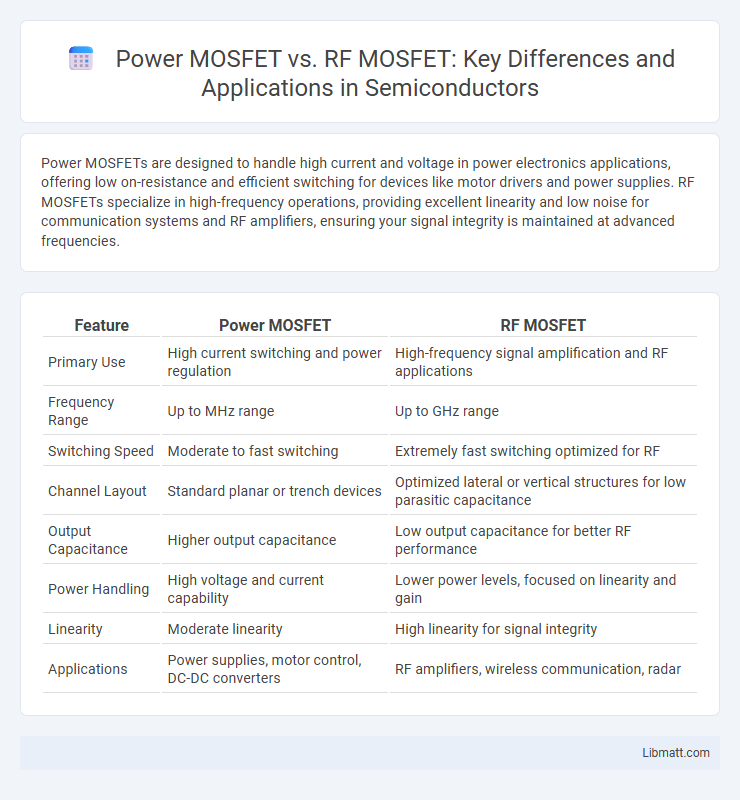Power MOSFETs are designed to handle high current and voltage in power electronics applications, offering low on-resistance and efficient switching for devices like motor drivers and power supplies. RF MOSFETs specialize in high-frequency operations, providing excellent linearity and low noise for communication systems and RF amplifiers, ensuring your signal integrity is maintained at advanced frequencies.
Table of Comparison
| Feature | Power MOSFET | RF MOSFET |
|---|---|---|
| Primary Use | High current switching and power regulation | High-frequency signal amplification and RF applications |
| Frequency Range | Up to MHz range | Up to GHz range |
| Switching Speed | Moderate to fast switching | Extremely fast switching optimized for RF |
| Channel Layout | Standard planar or trench devices | Optimized lateral or vertical structures for low parasitic capacitance |
| Output Capacitance | Higher output capacitance | Low output capacitance for better RF performance |
| Power Handling | High voltage and current capability | Lower power levels, focused on linearity and gain |
| Linearity | Moderate linearity | High linearity for signal integrity |
| Applications | Power supplies, motor control, DC-DC converters | RF amplifiers, wireless communication, radar |
Introduction to MOSFETs: Power vs RF Applications
Power MOSFETs are designed to handle high voltage and current loads, making them ideal for power conversion, motor drives, and switching applications in industrial and automotive sectors. RF MOSFETs excel in high-frequency performance, optimized for low noise and linearity in radio frequency amplifiers, communication devices, and wireless systems. The structural differences between Power MOSFETs and RF MOSFETs result in distinct electrical characteristics tailored to their respective power handling and high-frequency operational needs.
Fundamental Differences Between Power MOSFETs and RF MOSFETs
Power MOSFETs are designed primarily for handling high voltage and current in power conversion applications, featuring low on-resistance (R_DS(on)) and high avalanche energy capability for efficient switching and thermal management. RF MOSFETs specialize in high-frequency signal amplification with optimized gate layouts and minimal parasitic capacitances to ensure superior gain and noise performance in RF circuits. The fundamental difference lies in their structural design and performance metrics tailored respectively for power efficiency and high-frequency operation.
Construction and Design Variations
Power MOSFETs feature larger die sizes and thicker gate oxides to handle high current and voltage, optimizing for low on-resistance and thermal dissipation. RF MOSFETs incorporate smaller die sizes, thinner gate oxides, and specially engineered gate structures to minimize parasitic capacitances and improve high-frequency performance. Your selection depends on whether the design prioritizes power efficiency or signal integrity in high-frequency applications.
Key Performance Parameters Compared
Power MOSFETs typically offer low on-resistance (R_DS(on)) and high voltage ratings, enabling efficient switching and power handling in high-current applications, whereas RF MOSFETs prioritize high frequency response and low noise figure for optimal performance in radio frequency circuits. The gate charge (Q_g) in RF MOSFETs is minimized to enhance switching speed at GHz frequencies, contrasting with power MOSFETs that tolerate higher gate charge for better conduction efficiency. Breakdown voltage and thermal resistance are critical in power MOSFETs for durability under high power loads, while RF MOSFETs emphasize linearity and gain parameters to maintain signal integrity in communication systems.
Frequency Handling: High vs Low Frequency Operation
Power MOSFETs are designed for low-frequency applications, typically operating below 1 MHz, making them ideal for switching power supplies and motor control. RF MOSFETs excel in high-frequency operation, often above 100 MHz, enabling efficient amplification and signal processing in wireless communication systems. Understanding your frequency requirements ensures optimal device selection and circuit performance.
Efficiency and Power Dissipation
Power MOSFETs typically offer higher efficiency in low-frequency, high-current applications due to their low on-resistance (R_DS(on)), which minimizes conduction losses. RF MOSFETs are optimized for high-frequency operation, featuring low gate charge and reduced parasitic capacitances that improve switching efficiency but may exhibit higher power dissipation under heavy load conditions. Efficiency in Power MOSFETs is largely driven by conduction loss reduction, whereas RF MOSFETs balance switching speed and power dissipation to maintain performance at gigahertz frequencies.
Switching Speed and Gate Drive Characteristics
Power MOSFETs typically have moderate switching speeds suitable for high-current applications, with gate drive characteristics designed for efficient conduction and heat dissipation. RF MOSFETs feature significantly faster switching speeds optimized for high-frequency signals, with gate drive parameters tailored to minimize capacitance and enable rapid voltage transitions. Understanding the differences in switching speed and gate drive behavior helps enhance your circuit design for either power handling or high-frequency performance.
Typical Applications of Power MOSFETs
Power MOSFETs are commonly used in high-power applications such as voltage regulation, motor control, and power supplies for computers and consumer electronics. Their ability to handle large currents and voltages makes them ideal for switching power amplifiers and automotive electronics. Your designs benefit from improved efficiency and thermal performance when utilizing Power MOSFETs in these typical applications.
Typical Applications of RF MOSFETs
RF MOSFETs are specifically designed for high-frequency applications such as wireless communication devices, radar systems, and RF power amplifiers. These transistors offer low noise, high gain, and linearity, making them ideal for signal modulation and amplification in cellular phones, base stations, and satellite communications. You can rely on RF MOSFETs to enhance performance in RF circuits where efficiency and signal integrity are critical.
Choosing the Right MOSFET for Your Project
Choosing the right MOSFET for your project depends on understanding the distinct characteristics of Power MOSFETs and RF MOSFETs. Power MOSFETs excel in high-current, low-frequency applications with their low on-resistance and high efficiency, making them ideal for power management and switching. RF MOSFETs, optimized for high-frequency performance with low noise and fast switching speeds, are suited for wireless communication and RF amplifier circuits, ensuring optimal signal integrity and bandwidth.
Power MOSFET vs RF MOSFET Infographic

 libmatt.com
libmatt.com